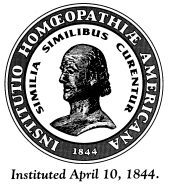The AIH seal
Early History of the Seal of the American Institute of Homeopathy
by Sandra M. Chase, MD, DHt
It was decided at the June 1997 meeting of the new Board of the American Institute of Homeopathy (AIH) that we wished to revise the seal for the organization. Having consulted homeopathic archivist William Kirtsos and, having researched the matter at the Maesimund B. Panos Library at the National Center for Homeopathy, I learned the following information.
The earliest depiction of a seal for the AIH appeared in an oval form, termed an elliptical by contemporaries on the 1867 bound copy of the Transactions of the Institute. Such a seal was still being used in 1881 when the Transactions of the World’s Homeopathic Congress in 1876 in Philadelphia were published. The elliptical seal consisted of a border within which the Latin designation of the Institute appeared with 1844 at the 6 o’clock position. Inside of the border was the Latin phrase Similia Similibus Curentur. In the center of the seal was a profile of Hahnemann, the rendering of which had such a high forehead as to suggest hydrocephaly. In 1883, a statement was added below the elliptical seal, Instituted April 10th, 1844. This device continued to be used through 1892.
At the Forty-Fifth Session of the American Institute of Homeopathy held at Washington, D.C., June 13-17, 1892, Dr. Thomas Franklin Smith of New York, NY, offered a resolution, to wit: Resolved, That a committee be appointed to procure for the official seal of the Institute a good portrait of Hahnemann. (Transactions, 1892. p. 136.) At this session, Dr. J. H. McClelland of Pittsburgh, PA, offered a motion that a committee be appointed to consider the erection of a monument to Hahnemann. (Ibid. pp. 61-62)
At the Forty-Sixth Session of the American Institute of Homeopathy held in Chicago, Illinois, May 29-June 3, 1893; the matter of the seal was presented in The Report of the Executive Committee by the General Secretary. It seems that the result of the work of the Committee on the Seal had been referred to the Executive Committee by the Committee’s Chairman, J. H. McClelland. The previous depiction of Hahnemann having been unsatisfactory, the report states, the Committee determined to use an authentic likeness of Hahnemann. They took three photographs of a bust made in life by the French artist P.J. David from 1837 when Hahnemann was 82 years old. This bust was gift to one of the American homeopathic colleges by Madame Hahnemann in 1876. Of the three photographs taken, the Committee selected a not quite profile view as bringing out best Hahnemann’s striking facial characteristics. Two designs were prepared, one elliptical, though less so than before, and one circular. The body politic adopted the recommendation for the new design for the Institute Seal and referred the selection between the elliptical and the circular one to the Senate of Seniors to make the selection. (Transactions, 1893, pp. 32-33) One is left to conclude that the Senate of Seniors chose the circular seal because the bound volume of the Transactions for 1893 edited by Pemperton Dudley, M.D., General Secretary, depicts the circular seal on its title page.
This circular seal continued to be used for a number of years. Specifically, it was the one in use in 1900 when the Hahnemann Monument was dedicated in Washington, D.C. Moreover, the bust that served as resource for the profile in the seal was also used as the model for the head of Hahnemann’s statue in that monument. (Historic Sketch of the Monument)
The seal that the AIH has adopted for use currently is an adaptation of the seal created in 1893 that continued in use in 1900 when the Hahnemann Monument was dedicated in Washington, D.C. It somehow seems appropriate that into the year 2000 when we celebrate the centennial of the dedication of the Hahnemann Monument, the American Institute will be using a seal derived from that historic seal in which appears a rendition of Hahnemann’s head which has a common source to that used in the monument.
Newsletter of the American Institute of Homeopathy, Volume 153, Issue 4, Winter 1998



